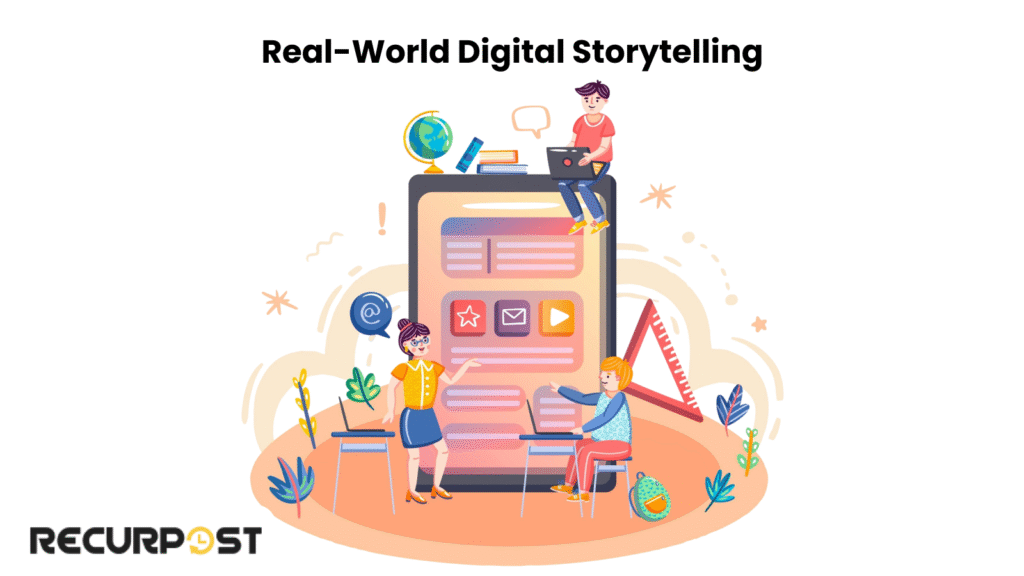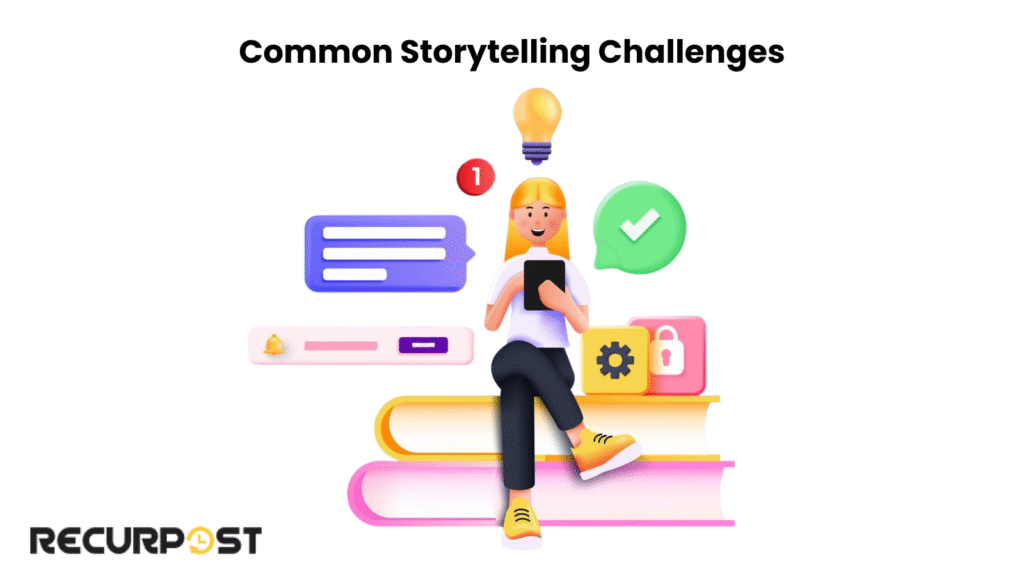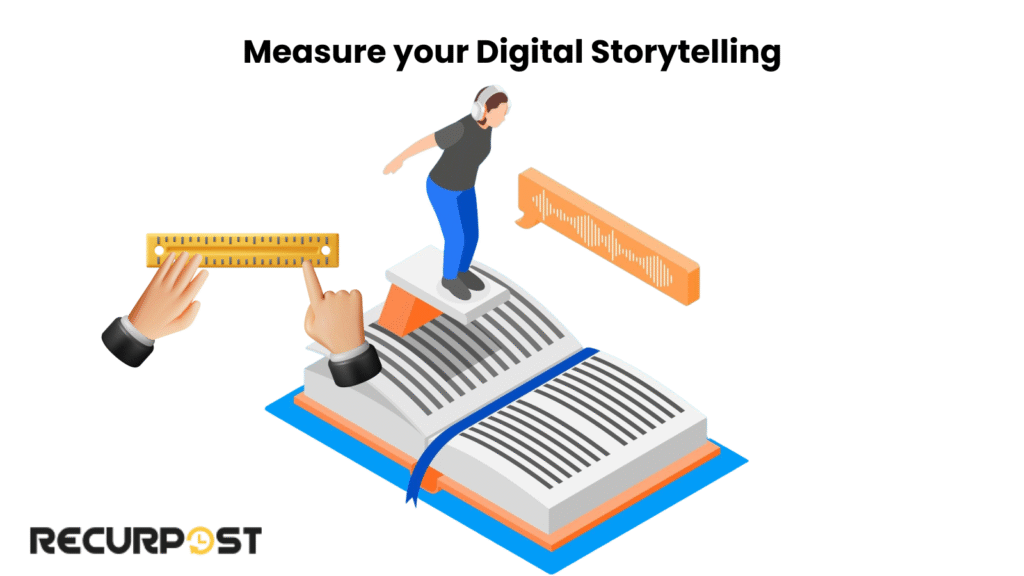Scroll. Tap. Skip. That’s how most content lives and dies today.
Digital storytelling makes viewers stop and feel something.
Viewers don’t just skim, they smile, nod, and share content that connects.
The answer lies in a good story.
Digital stories feel real, look great, and stick with people long after they’ve moved on.
Brands, freelancers, and social media managers craft stories that boost engagement, spark curiosity, and create real conversations. Digital storytelling transforms content into creative expression
This article explains how digital storytelling works in crowded digital spaces and how to apply it effectively with visual storytelling techniques.
Ready to tell better stories?
What Is Digital Storytelling?

Digital storytelling transforms messages into stories people care about through screens. Digital storytelling combines visuals, sound, text, motion, and user-generated content. Examples include Instagram Reels that evoke emotion or brand pages that read like mini movies.
Digital storytelling creates emotional connections by crafting characters, building tension, and showing audiences where they fit in the journey rather than listing facts.
Freelancers, small businesses, and solo creators use visual storytelling to stand out with striking images, short-form videos, or well-timed memes that evoke emotions and make viewers feel included.
Digital storytelling isn’t just storytelling on a screen. It’s storytelling built for the screen.
Why Stories Work: The Science Behind Engagement

Some posts go viral while others disappear because human brains are wired for stories. People remember stories 22 times more than plain facts. When a story unfolds, the brain activates as if experiencing the events firsthand.
Stories change behavior by triggering emotional resonance, making people more likely to trust, act, and share content. Adding visuals increases message retention by 65%.
Digital storytelling guides audience behavior, builds brand loyalty, and converts scrolling into clicking.
Digital storytelling invites audiences into narratives where they see themselves, rather than simply selling products.
The Core of Every Digital Story: What You Need to Make it Work

Digital stories require both emotional resonance and structured elements.
Here’s what brings a digital story to life:
1. A Clear Core Message
Digital stories need one central message that audiences will remember. Stories without a clear focus fail to create emotional connections.
2. A Relatable Character or POV
Give your story a face. A customer. A team member. A pet parrot. Doesn’t matter, just someone (or something) your audience can care about.
3. Visual Elements That Speak
This is where visual storytelling steps in. Use images, motion graphics, or even GIFs to make complex ideas easy and fun. Visual cues help guide the narrative forward and keep attention locked in.
4. Emotional Triggers
Joy, nostalgia, surprise, and emotions are the fuel. If people don’t feel anything, they won’t do anything.
5. A Natural Flow
Every good story follows a rhythm. Beginning, tension, climax, and payoff. Even a short-form video on TikTok follows this narrative flow.
6. A CTA That Feels Like a Next Step, Not a Sales Pitch
“Buy now” is boring. “Start your own story” feels better. Give your audience something that fits the vibe of your story.
Add interactive elements, sprinkle in multimedia, and keep your tone human. That’s how you turn passive viewers into active participants.
Crafting Stories That Boost Engagement

Most digital stories don’t stick. They scroll by. Forgotten in seconds. Why? Because they’re just content. Not stories.
Here’s how to craft stories that your audience feels, and clicks, comments, or shares without a second thought:
1. Start with your audience, not your brand
Your story isn’t about you. It’s about them. Their problems, their goals, their world. Get clear on who they are. Build audience personas. Speak their language.
2. Hook ‘em fast
Attention spans are short. Use a bold visual, a relatable question, or a funny one-liner to grab attention in the first few seconds. That’s your narrative hook.
3. Use real stories, not slogans
“Best in the business” means nothing. But showing how a small biz owner used your product to land their first 10 clients? That’s gold. Real stories = real connection.
4. Make it interactive
Polls, sliders, choose-your-own-adventure stories interactive content pull people in and keep them around. It turns watchers into participants.
5. Blend your visuals and words
Compelling visuals carry emotion. Motion adds energy. Words add clarity. Put them together, and boom, you’ve got a visually compelling story that hits hard.
6. End with something they can do
Don’t leave people hanging. Whether it’s “share your own story”, “try the free version”, or “drop a comment”, your call-to-action should feel like part of the story, not a pitch slapped on at the end.
In a crowded digital era, stories serve as your voice. Make yours one worth hearing.
Tools and Platforms for Digital Storytelling

Platforms like Canva, Adobe Express, InVideo, and Instagram Stories enable visual storytelling with multimedia elements, including sound effects and interactive content that create emotional connections.
AI-powered tools streamline video editing and social media management while providing engagement metrics that reveal audience behavior patterns.
When picking a platform, focus on your core objective and target audience:
- Some tools excel for visually compelling short stories on TikTok and Instagram Reels.
- Others suit longer videos or blog-style digital stories explaining complex concepts.
- Many offer free versions to start creating interactive stories, with paid plans for more features.
Using the right tools helps you craft stories that stand out in a crowded digital landscape.
Audience Research and Persona Building

Digital storytelling starts with understanding your target audience. Building detailed audience personas by analyzing audience behavior through social listening, surveys, and analytics tools reveals pain points and preferences.
Understanding audience motivations enables tailored visual stories that maintain consistency, emotional connection, and narrative momentum that resonates with viewers.
Real-World Digital Storytelling Examples (That Worked)

These brands created digital stories that stopped viewers from scrolling, demonstrating effective storytelling techniques.
1. Airbnb’s “Host Stories”
Instead of bragging about properties, Airbnb hands the mic to its hosts. Through short videos and written posts, they spotlight real people and their own stories. The result? Emotional connection. Trust. A brand that feels human.
2. Nike’s “You Can’t Stop Us” Campaign
This was visual storytelling at its peak. Split-screen videos showing athletes across the world moving in sync. It spoke volumes without needing heavy text. A good story doesn’t have to say much, it just has to feel right.
3. GoPro’s User-Generated Videos
GoPro doesn’t push product features. They let their customers do the storytelling. Skydives, hikes, underwater shots, all told through the lens of their own users. It’s authentic. It encourages interaction. And it builds serious brand loyalty.
4. Dove’s “Real Beauty Sketches”
This one? An emotional punch. Dove asked women to describe themselves to a sketch artist, then had someone else describe them. The contrast? Shocking. It sparked conversations about beauty, identity, and self-image. Storytelling that shifted audience behavior.
5. Spotify Wrapped
Your year in music turned into a story. Spotify doesn’t just show stats, they package your listening habits into shareable, colorful, interactive stories. It’s personal. It’s fun. It’s wildly shareable.
Every one of these digital storytelling examples used relatable characters, emotional triggers, and visually compelling content. And the engagement metrics speak for themselves.
Tips to Keep Your Digital Storytelling Sharp (and Share-Worthy)

Online audiences have brief attention spans and scroll quickly. These techniques make digital stories memorable:
1. One story, one core message
Don’t cram five points into one post. Pick a single message and build everything, words, visuals, vibe, around it. Clarity wins.
2. Use visuals that speak louder than your caption
Think less stock photo, more striking image. Show real moments. Visual cues can spark memory retention way better than text-heavy slides ever will.
3. Always anchor back to your audience
What do they care about? What makes them laugh, cry, click, or share? Your audience isn’t a metric, they’re people. Craft stories that feel like you get them.
4. Emotions > Information
You’re not writing a Wikipedia entry. Make people feel something. Humor, joy, fear, nostalgia emotional connection are what keep stories stuck in our brains.
5. Mix up the format
Don’t just stick to one medium. Use reels, carousels, interactive stories, email narratives, blog stories, whatever fits the story best. Multimedia elements help you reach more eyeballs.
6. Repurpose the good stuff
That killer carousel? Turn it into a video. That viral tweet thread? Spin it into a blog. Great stories are like pizza, just as good the next day in another form.
7. Watch the engagement metrics
Shares. Saves. Comments. Clicks. These tell you which stories resonate deeply and which ones need tweaking. Don’t ignore the numbers, they’re just your audience talking back.
Keep the storytelling process fun, flexible, and real. For inspiration, check out these Instagram story ideas that will help bring more views and followers to your account. That’s what keeps people coming back for your next post.
Overcoming Common Storytelling Challenges

Digital storytellers face writer’s block, authenticity-branding balance challenges, and resource limitations. Revisiting core messages and brand values maintains narrative flow, while interactive stories and visual elements inspire ideas and encourage participation.
Strategic planning tools and templates streamline the storytelling process and help handle the demands of a competitive market. Embrace imperfection and share stories honestly to build meaningful connections and strengthen brand loyalty in the long run.
Why Digital Storytelling Works (The Psychology Bit)

Stories activate brain regions associated with emotions, memories, and movement, creating deeper neural connections than simple information sharing.
Here’s the cool part:
1. Emotional connection sparks action
When people feel something, they remember it longer and share it more. That emotional resonance helps brands build loyalty and keep their audience hooked.
2. Our brains love patterns and flow
A well-crafted narrative with a clear beginning, middle, and end fits how we naturally process info. It makes complex ideas feel simple and memorable.
3. Visuals boost memory retention
Adding striking images or videos makes your story pop in the mind, improving recall by up to 65%. That’s a big win for brand recall.
4. Interactive stories create active participation
When your audience can click, swipe, or choose, they move from passive viewers to active participants. That engagement deepens the connection.
Put all that together, and you’ve got a powerful tool that makes your message stick and your audience act.
How to Measure If Your Digital Storytelling is Working

Measuring digital storytelling effectiveness requires tracking these key metrics:
1. Engagement metrics
Look beyond just likes. Check shares, saves, comments, and time spent on your content. The longer someone sticks around, the better your story’s working.
2. Click-through rates (CTR)
If your story nudges people to take action, whether that’s signing up, visiting your site, or downloading something, the CTR will show you how well your call-to-action lands.
3. Audience behavior changes
Are more people following your page? Sharing your posts? Joining your community? Those shifts tell you your story resonates and builds loyalty.
4. Conversion rates
Ultimately, stories should nudge people closer to your core objective: buying, subscribing, or joining your newsletter. Tracking conversions tells you how persuasive your story is.
5. Qualitative feedback
Comments, direct messages, and reviews are gold mines. Real people sharing their thoughts and feelings can show you what’s working emotionally.
Keep an eye on these numbers and signals; they’re like a conversation with your audience, telling you what to do next.
Storytelling Formats and Channels

Understanding the strengths of different formats lets you craft stories that resonate and create an emotional connection with your target audience.
- Short-form videos like Instagram Reels, TikTok, and YouTube Shorts use visual cues and visual narratives to quickly evoke emotions and grab attention in the fast-paced digital world.
- Instagram Stories, Facebook Stories, and LinkedIn Stories offer intimate, interactive content with polls and Q&As, encouraging community building through real stories and user-generated content.
- Blogs and emails allow for compelling narratives that explain complex ideas or complex data in detail, helping boost website traffic and strengthen brand identity.
- Podcasts and live streams combine creative expression with real-time collaboration, fostering a deeper connection and immediacy with the audience.
Future Trends in Digital Storytelling

Digital storytelling evolves through augmented reality (AR), interactive 360° videos, and immersive visual narratives. AI-driven personalization adapts stories in real time based on audience behavior and preferences.
Additionally, the rise of short-form, ephemeral content reflects a shift in how users consume digital stories across multiple social media channels. Following these trends keeps your storytelling relevant and encourages interaction and brand loyalty in the digital space.
Legal and Ethical Considerations

Respect copyright and intellectual property when using images, music, or user generated content to maintain trust and authenticity. Brands should be transparent in their storytelling, avoiding exaggerated or misleading claims to preserve emotional resonance and credibility.
Ethical storytelling practices protect your brand, foster meaningful connections, and encourage community building in a socially responsible way.
Bringing It All Together: Your Story, Your Edge
Digital storytelling transforms messages into content people actively engage with. Stories that resonate emotionally and visually cut through crowded digital spaces.
Remember, the best stories focus on one clear message, use real emotions, and invite your audience to become part of the story. Mix up formats, keep your visuals striking, and listen to what your engagement metrics tell you.
Your stories serve as bridges, connecting your brand’s values to your audience’s hearts. When done right, they build trust, boost loyalty, and inspire action.
So, what story will you tell today?
Frequently Asked Questions
1. How long should a digital story be?
Keep it concise. Whether it’s a social media post or video, 1-3 minutes or a few scrolls usually work best to hold attention.
2. Can small businesses use digital storytelling effectively?
Absolutely! Small businesses can share authentic, relatable stories that highlight their unique brand personality and connect deeply with their audience.
3. What tools can help me create digital stories?
There are many options, from simple video editors and graphic design apps to interactive content platforms and social media story features.
4. How often should I post digital stories?
Consistency matters more than frequency. Find a rhythm you can maintain without sacrificing quality or creativity.
5. How do I keep my stories authentic?
Share real experiences, user-generated content, and honest brand values. Authenticity builds trust and emotional connection.
6. What’s the difference between digital storytelling and content marketing?
Digital storytelling focuses on narrative and emotional connection, while content marketing covers all types of content. Storytelling is a powerful way to make your content memorable.
7. Can digital storytelling improve SEO?
Yes! Engaging stories tend to get more shares, longer view times, and backlinks, all of which can boost your search rankings.
8. How can I make my stories more interactive?
Add polls, quizzes, clickable links, or user-generated content to invite your audience to participate and engage actively.
9. Is video storytelling better than written stories?
Both have their place. Video often grabs attention faster and appeals visually, but written stories can go deeper and be more shareable in certain contexts.
10. How do I measure the ROI of digital storytelling?
Track engagement, conversions, website traffic, and brand sentiment to see how your stories impact your business goals.

As a passionate content writer, I love blending creativity with research to craft compelling narratives that inform, engage, and inspire. With a strong focus on user engagement and brand communication, I create content that resonates with the audience and drives meaningful interactions.
